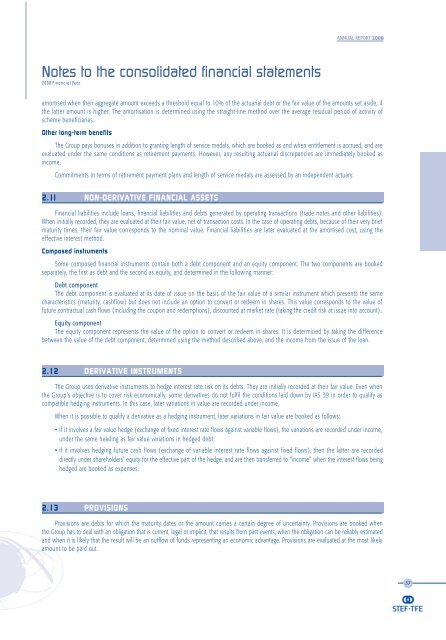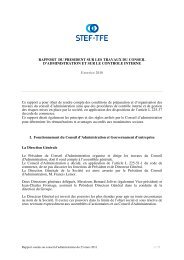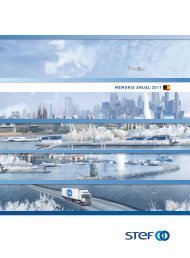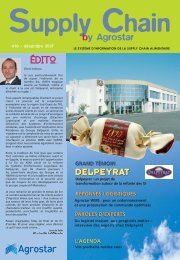Create successful ePaper yourself
Turn your PDF publications into a flip-book with our unique Google optimized e-Paper software.
Notes to the consolidated financial statements<br />
<strong>2008</strong> Financial Year<br />
ANNUAL REPORT <strong>2008</strong><br />
amortised when their aggregate amount exceeds a threshold equal to 10% of the actuarial debt or the fair value of the amounts set aside, if<br />
the latter amount is higher. The amortisation is determined using the straight-line method over the average residual period of activity of<br />
scheme beneficiaries.<br />
Other long-term benefits<br />
The Group pays bonuses in addition to granting length of service medals, which are booked as and when entitlement is accrued, and are<br />
evaluated under the same conditions as retirement payments. However, any resulting actuarial discrepancies are immediately booked as<br />
income.<br />
Commitments in terms of retirement payment plans and length of service medals are assessed by an independent actuary.<br />
2.11 NON-DERIVATIVE FINANCIAL ASSETS<br />
Financial liabilities include loans, financial liabilities and debts generated by operating transactions (trade notes and other liabilities).<br />
When initially recorded, they are evaluated at their fair value, net of transaction costs. In the case of operating debts, because of their very brief<br />
maturity times, their fair value corresponds to the nominal value. Financial liabilities are later evaluated at the amortised cost, using the<br />
effective interest method.<br />
Composed instruments<br />
Some composed financial instruments contain both a debt component and an equity component. The two components are booked<br />
separately, the first as debt and the second as equity, and determined in the following manner:<br />
Debt component<br />
The debt component is evaluated at its date of issue on the basis of the fair value of a similar instrument which presents the same<br />
characteristics (maturity, cashflow) but does not include an option to convert or redeem in shares. This value corresponds to the value of<br />
future contractual cash flows (including the coupon and redemptions), discounted at market rate (taking the credit risk at issue into account)..<br />
Equity component<br />
The equity component represents the value of the option to convert or redeem in shares. It is determined by taking the difference<br />
between the value of the debt component, determined using the method described above, and the income from the issue of the loan.<br />
2.12 DERIVATIVE INSTRUMENTS<br />
The Group uses derivative instruments to hedge interest rate risk on its debts. They are initially recorded at their fair value. Even when<br />
the Group's objective is to cover risk economically, some derivatives do not fulfil the conditions laid down by IAS 39 in order to qualify as<br />
compatible hedging instruments. In this case, later variations in value are recorded under income.<br />
When it is possible to qualify a derivative as a hedging instrument, later variations in fair value are booked as follows:<br />
• If it involves a fair value hedge (exchange of fixed interest rate flows against variable flows), the variations are recorded under income,<br />
under the same heading as fair value variations in hedged debt;<br />
• If it involves hedging future cash flows (exchange of variable interest rate flows against fixed flows), then the latter are recorded<br />
directly under shareholders' equity for the effective part of the hedge, and are then transferred to "income" when the interest flows being<br />
hedged are booked as expenses.<br />
2.13 PROVISIONS<br />
Provisions are debts for which the maturity dates or the amount carries a certain degree of uncertainty. Provisions are booked when<br />
the Group has to deal with an obligation that is current, legal or implicit, that results from past events, when the obligation can be reliably estimated<br />
and when it is likely that the result will be an outflow of funds representing an economic advantage. Provisions are evaluated at the most likely<br />
amount to be paid out.<br />
57










